 Leading Blog | Posts by Month |
 Leading Blog | Posts by Month |
04.30.22

LeadershipNow 140: April 2022 Compilation
See more on
Posted by Michael McKinney at 06:43 AM
04.29.22

Qunicy Jones with 12 Notes on Life and Creativity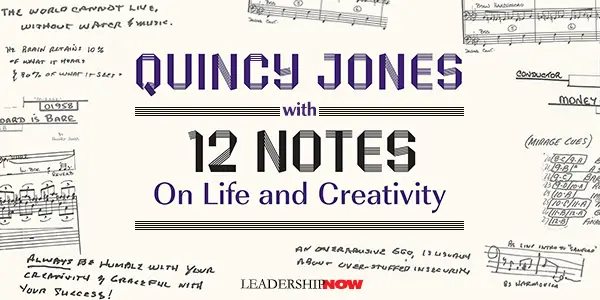
IN music, there are only 12 notes. It’s how you play them that matters. In 12 Notes on Life and Creativity, Quincy Jones shares how he played his. This is an autobiography that serves to highlight teachable moments. His biographical stories make each of these lessons come alive. It’s not a formula for success but a conversation about the “lessons he’s learned, the advice he’s received, and the conclusions that he has come to about life and creativity that have allowed him to live an enriched life, full of highs and lows.” His words will enrich you. Note A: Recycle Your Pain into Purpose Having lived almost 90 years, Quincy says that the best part is being able to “look back on each stage of life and see the visible threads that held it all together.” With the inevitability of hardship in this often broken world, it’s important to understand what fills your voids and also where you are projecting yours. The moment you slip into a victim mentality, not only are you faced with having to deal with external problems, but you’ve also given yourself a whole new set of internal problems that will only stunt your growth as both a human and a creative being. Note A#: If You Can See It, You Can Be It Quincy didn’t grow up in the best of circumstances, but he relentlessly pursued hope. It’s easy to believe that you are stuck wherever you are and nothing will change, but you can outgrow your circumstances—the pollution of your surroundings. Growth is just a journey from mind pollution to mind solution. In other words, you have to sift through the dirt of whatever situation it is that you find yourself in, so that your future isn’t polluted before you’ve even had a chance to create it. Quincy says survival is an act of creativity. “It’s a matter of seeking out new ways to stay inspired, and creating paths that lead to a better future for yourself, and in turn, others.” Note B: You Gota Go to Know Step outside your comfort zone—you gotta go to know. But to go, you have to know your history—personal and national. History is important. You’ve got to know where you come from in order to get where you want to go. Without that foundation, you won’t know who you are, and you sure can’t expect to create truthfully without knowing the truth. Note C: Establish Your Guideposts Guideposts create a foundation for you to build a life on. They define who you are. “Set up guideposts that routinely remind you of who you are, apart from the distraction of life.” With a general understanding that our thoughts play an important role in the direction of our paths, it’s essential to remain proactive in training those thoughts to continue pointing north, with the assistance of guideposts, whatever form they may come in for you. Note C#: Always Be Prepared for a Great Opportunity If you prepare in advance, you will be ready when the call comes without thinking it over. Practice so you will be ready for the right opportunities that will come your way. Always do your best. Everything in your life is a chain reaction, and your ability to deliver will usually be judged based on your last encounter. Note D: Sharpen Your Left Brain Learn the science behind your craft. Go deep. It will change the way you create. “Without taking the time to fine-tune your skills, your efforts will be built on a foundation that is bound to crumble once it is put to the test.” Quincy says, “Once I learned how to properly notate music, or sync music to picture when I began film scoring, or produce compelling live shows using scientific methods, I was able to take my artistry to the next level. Learning how to sharpen my left brain has been largely influential in how I’ve approached every creative endeavor.” It gave him credibility, too. He mixes “science with soul.” Note D#: Avoid Paralysis from Analysis How quickly can you get unstuck? That's what matters. Quincy offers four practices to help with this. We so often dismiss our greatest ideas, thinking they’re supposed to make some type of grand entrance when, in reality, they may often just present themselves in the form of a whisper. Note E: The Power of Being Underestimated Don’t focus on what other people think of you. There will always be people who will diminish you. Instead, focus on your goals and what you are capable of. “If people overestimate you, they get in your way, but if they underestimate you, they get out.” Instead of chasing fame, lean into your time of obscurity, or position of unexpected greatness, to plan and prepare for your next endeavor. Note F: Do What’s Never Been Done Before Don’t compare yourself to others. “It’s easy to look at others and justify why they can and you can’t.” Think big. “I’ve found beauty in the unknown by simply giving my mind freedom to explore.” I have to warn you though: Big dreams don’t come without big failures. Things get tough and you will make mistakes. Repeatedly. We’re human and we’re going to flounder, but it’s what you do to get back up that matters. If I allowed myself to stay in the downward swings, then I’d still be there. Note F#: Understand the Value of Relationships This lesson is profound and largely lost on too many today: If you do everything correctly, but don’t take heed to this next lesson I’m about to share, then it will all go to waste. So, please hear me when I say that you need to work on yourself just as much as you work on your art. As my former music teacher Nadia Boulanger always used to tell me, “Quincy, your music can never be more or less than you are as a human being.” It doesn’t matter how talented you are—or how many number-one hits you get—if you don’t work on who you are first. Your personal life and your professional life are linked. What you do in private impacts what you do in public. You must have humility with your creativity, and grace with your success. Bandleader and pianist Count Basie taught him a great lesson about integrity, recounted in this Note that you have to read. He also told him, “Learn to deal with the valleys, because the hills will take of themselves.” Note G: Share What You Know As recounted on the pages of this book, Quincy benefited from the lessons taught to him by the musical greats. Mentors that took the time with him to give him confidence and develop his potential. We all need mentors and can be mentors. There really would be no such thing as a generation gap, if we only had enough people willing to lift each other up, instead of tear each other down. Note G#: Recognize the Value of Life Quincy has had a few near-death experiences in his life. These near-endings became beginnings for him. We often think of life as a series of events that happen to us. As a result, we neglect the fact that it’s often a series of actions that we do to ourselves. How will you play your 12 notes? 
Posted by Michael McKinney at 08:23 AM
04.28.22

Leading Thoughts for April 28, 2022
IDEAS shared have the power to expand perspectives, change thinking, and move lives. Here are two ideas for the curious mind to engage with: David Baldacci’s character Aloysius Archer on resilience: “From now on his life path would be pointed steadily forward, right at the fresh waves coming for him, rather than the choppy ones that had just passed underneath and battered him. Source: Dream Town Tim Elmore on the difference between adapting and adopting: “The key to good leadership is catching the wind and capitalizing on it to take you where you need to go. And, perhaps more importantly, to take the students under your care where they need to go. Our job is not merely to adopt what’s trending in our culture. Leaders don’t just fit in. Our goal is to adapt, not adopt. There’s a huge difference. We adapt to the realities of our day, leveraging current methods to say what must be said to our young. Once again, we are timely in our methods, but timeless in our mission. We are timely in our communication style, but timeless in our content. We are timely in our pedagogy, but timeless in our purpose.” Source: Marching Off the Map: Inspire Students to Navigate a Brand New World Look for these ideas every Thursday on the Leading Blog. Find more ideas on the LeadingThoughts index.
Posted by Michael McKinney at 07:12 AM
04.26.22

Reach: How to Grow Your Influence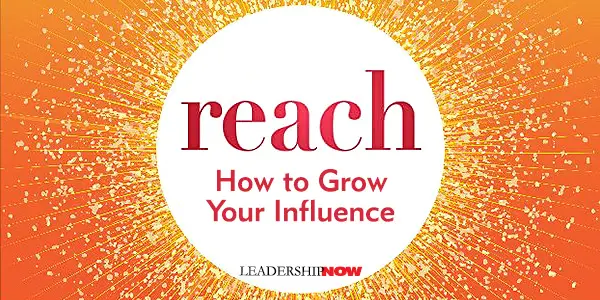
DIGITAL marketer Becky Robinson brings her years of experience together in Reach: Create the Biggest Possible Audience for Your Message, Book, or Cause. The key foundational principle is that reach—your ability to not only expand your audience but make a meaningful and enduring difference—is never static, and it is the product of your work and its impact over time. All leaders need to think about reach in the way that Robinson describes it. We have ideas that we want to share that we hope will gain traction with our audience. We tend to think of reach in terms of followers. If I have a lot of followers, I have a lot of reach. But there is more to it than that. Do your followers open your emails? Do your followers engage with and act on your content?
Value: Focus on creating value. Knowing your audience will help you to focus your efforts on creating content that will provide value to them—practical content that will resonate with them. Share your experiences with your niche market. Longevity: Take a long-term view of your work. “To create lasting impact, you need to have a lasting presence. The longer you last, the greater the impact you will have.” Don’t give up too soon. Consistency: Consistency is not easy to achieve. You need to implement a sustainable approach that works for you. A consistent approach rewards people’s expectations of you. “When you are consistent about creating and adding value, you amass a body of work through your online presence that is credible, valuable, and useful to your online audiences. You become a treasured resource.” Generosity: “Making meaning and making a difference is impossible without a desire to give to others.” Giving away content does not undermine your business success. It actually helps to build it as it creates trust. Generosity also means supporting the work of others online, whether or not they reciprocate the favor. Value, consistency, longevity, and generosity are all important as you seek to achieve reach. Without value, you have nothing to offer and no reason for people to pay attention to you. Generosity is the vehicle for delivering value. The more value you give away, the more you draw people’s interest and attention. Without consistency, it’s difficult to get traction. You may get attention when you launch but fail to create momentum that will help you get beyond your own networks. Without longevity, you may create impact for a moment then fade into obscurity. Robinson delves into the nuts and bolts of expanding reach, from creating websites, repurposing content, writing a book, launching a campaign, to building email lists. Woven throughout all of that are the four commitments using relatable examples of others who have successfully built their reach. While you may be familiar how these four commitments that Robinson presents in Reach apply offline as well, she has adroitly applied them to an online world where you can take advantage of them to create influence like never before. 
Posted by Michael McKinney at 03:19 PM
04.21.22

Leading Thoughts for April 21, 2022
IDEAS shared have the power to expand perspectives, change thinking, and move lives. Here are two ideas for the curious mind to engage with: Consultant Stan Slap on the purpose of leadership: “The irreducible essence of leadership is that leaders are people who live their deepest personal values without compromise, and they use those values to make life better for others—this is why people become leaders and why people follow leaders.” Source: Bury My Heart at Conference Room B: The Unbeatable Impact of Truly Committed Managers Tom Morris on the Rule of Reciprocity: “One problem with the Rule of Reciprocity is that when you live by it, you allow others to call the shots. Like it or not, we deal with people every day who fall into this pattern of conduct and just reflect back to us whatever we do to them. This is a truth of great importance since it gives us one of the main reasons why unethical business practices are self-destructive. It may be easy to treat people badly one by one, or a few at a time, but over the long run, if you have treated enough other people terribly, and they are living reciprocally, then they are out there as a growing multitude preparing to do the same to you. And together, they’ll eventually have the power to bring you down.” Source: Art of Achievement: 7C’s of Success In Business and Life Look for these ideas every Thursday on the Leading Blog. Find more ideas on the LeadingThoughts index.
Posted by Michael McKinney at 12:40 PM
04.20.22

You Don’t Need a Cape to Be a Hero to Your People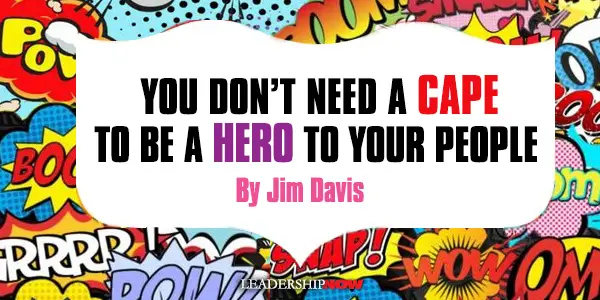
HERO can be a relative term. It can conjure images of stilled action in the pages of a comic book or computer-generated images on the big screen of good versus evil. For those who live in the real world, the relevance is much more practical and actual. Heroes lift the souls of those who read about their stories of bravery and the causes they champion at every turn of the page. Villainy must be vanquished, just as the challenges in everyday life we all face. No cape required. There are nine “superpowers” each aspiring leader can employ that will help him or her be the champion people need and deserve. 1. The Power of Vision It all starts with something better. Or, at least, it should. That’s the power of vision. Vision is simply a snapshot, or image, of a preferable future. It’s the way things can be, ought to be, and will be, if impassionedly pursued. The concept of heroes and their sense of idealism represents something more. Something better. It can help us see beyond the now into our best tomorrow. Vision is the ability and awareness that prompted non-powered individuals to create, invent, and otherwise shape the future in truly remarkable ways. 2. The Strength to Win No matter the story, foe, or situation, each hero, we believe, will eventually prove to be the champion we all knew he or she could be. The certainty and anticipation of victory is tied to the strength every hero displays, even in the face of dire straits or great adversity. This is just one reason heroes are so celebrated and revered. The strength to win is an attitude and a spirit that will not allow a person to live under the circumstances but rise above them with a resilient refusal to lose. 3. The Value of Trust Trust is not automatic. It must be earned, not given. We trust another because we learn, over time, that he or she is worthy of it. We know they will do the right thing, every time. We trust those who come through, over and over, and we freely relate with, absent of any doubt, those who work hard to protect and cherish that confidence. We confide in another because we’ve given ourselves permission to do so. Otherwise, we simply look elsewhere or, if given no choice, offer as much trust as the situation deserves and hope for the best. For the heroic leader, trust is the foundation on which everything else is built. When trust is secure, communication is healthy, productivity is higher, as is morale, and the opportunities for group success are more readily available. 4. The Price of Prowess You have to give up to go up—John Maxwell. Leadership is a skill that can be taught and developed. It’s not magic. It’s not mystically bestowed. Every leader possesses some prowess, but it’s not easily or lazily expanded. Measure of influence is determined by the current degree of leadership. We all have a ceiling that doesn’t, and shouldn’t, remain permanent. Many never leave what could be described as entry-level or positional. Don’t get stuck. Challenge your competency and work to grow. 5. The Passion of a Just Cause Everyone needs a cause. Everyone needs a calling bigger than self, a passion that will not only energize their life but change someone else’s. Without it, the sense of merely existing takes hold, and one simply takes up space until the end. Not enough are driven by a strong sense of mission, purpose, or a reason that produces a call that must be answered with enthusiasm and passion on a daily basis. While each life has a definite purpose, causes can be presented at various times in alignment with one’s mission and calling. Every life is a story waiting to be told. A great commitment to a great cause will build a great life and speak volumes to the world about who you are, what you believe, and the difference you want to make. Never make a first-class commitment to a second-class cause. 6. The Reality of Hope You can survive 40 days without food, three days without water, and eight minutes without air. You can’t honestly survive a single second without hope. Hope is as vital as the air we breathe. Without it, life becomes an exercise in finding as many ways as possible to cope or just get by. People no longer thrive. They merely survive. Every leader can authentically present the reality of hope that will spur their team forward despite, and even because of, hard seasons. 7. The Honor of Fighting Fair Conflict is inevitable. It can’t be avoided. When people attempt to, with a head in the sand approach, the conflict that inevitably surfaces is worsened by a lack of readiness. The typical manager spends 25–40% of his or her time dealing with workplace conflict. Another term for this is putting out fires. While conflict can’t be eluded, it doesn’t have to be ruinous. Disagreements, if handled properly, can make a team better, not bitter. This requires attacking the issues, however, not each other. 8. The Leveling of Calm No one gets to choose when moments of stress and difficulty occur. While we can’t control when bad moments will strike, one can control what to do with them and what happens next. This is what separates the mature leader, the heroic leader, from the average person who never rises above impulsively reacting to bad situations instead of carefully responding. 9. The Heart to Serve Heroic leadership is not power over people, but power with people. It’s paradoxical, but true greatness comes from proving to be the least, in so much as expressing a willingness to consider others as much as self. People hate pretense and can usually see through a façade. Serving others, especially those you lead, must be genuine. The main question is, “Do I care about the people I’ve been blessed to lead, or do I only care about getting the job done?”  
Posted by Michael McKinney at 08:15 AM
04.18.22

How to Make Difficult Decisions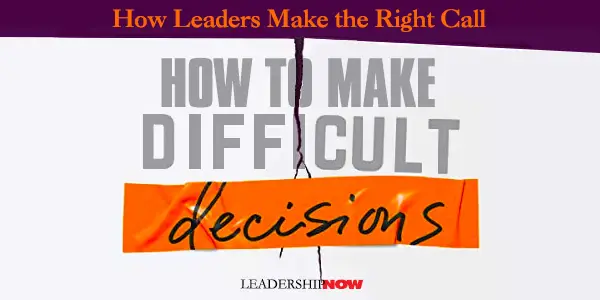
MOST difficult decisions are not difficult because we lack information but because we are juggling three subjective dimensions: moral, ethical, and our role responsibilities. While I believe that there are black and white absolutes that cross all boundaries, we live in a world that presents us with gray areas and nuances. Knowing how to apply your morals and ethics in the context of your job is critical to effective decision-making. We like to think we are objective, but the circumstances often call for subjectivity. Machine learning and artificial intelligence are not bias-free and can’t tell us what to do and the consequences of our decisions. In Difficult Decisions, Eric Pliner says we have to rely on our judgment, and “our ability to make those judgments skillfully is informed by what’s going on inside of us, what’s going on around us, and what we understand is expected of us.” This presents us with the Moral-Ethical-Role Responsibility Triangle.
It works like this: For example, “when my role requires me to engage in activities that are generally considered acceptable (Ethics) but that I personally believe to be wrong (Morals), the moral and role responsibilities dimensions of the triangle are in conflict. In those cases, I use my morality to challenge my role responsibilities (a one-time proposition), or I can look to contextual ethics – what does the world at large have to say about what I am being asked to consider or do? – to help me to test the extent and depth of my morality.” Naturally, you could quit (a one-time option), but the goal is to stay engaged and lead even when you are navigating contradictions. This triangle framework helps to sort out the issue in our mind in relation to our decision-making ecosystem when dealing with difficult decisions. The intersection of these three constructs informs how we make decisions: what we believe at our core; what we understand to be acceptable in our current sociocultural or sociopolitical context; and what we commit to, explicitly and implicitly, by taking on a role—formally or informally—in an organization, a community, or even a family. When these align, decision-making is easy. When they do not—and for the most difficult challenges, they usually don’t—our ability to understand each element on its own, and sort through their apparent conflict, is at the heart of whether we can make difficult decisions with skill, insight, and empathy. Pliner takes us through each of the three dimensions of the triangle to help us understand and be fully conversant with each. Knowing your moral boundaries, the ethical context of the times you lead in, and your understanding of your role will help to strengthen your ability to make difficult decisions when you are called upon to do so. Your job as a leader is to affirm the decision you’ve made—to reflect on how you got there, be clear about what you plan to communicate about both the decision and the process of arriving at it, and to whom you intend to communicate and how to match your message with their priorities and belief and interests. 
Posted by Michael McKinney at 09:01 PM
04.15.22

7 Impactful Practices for Women Navigating Leadership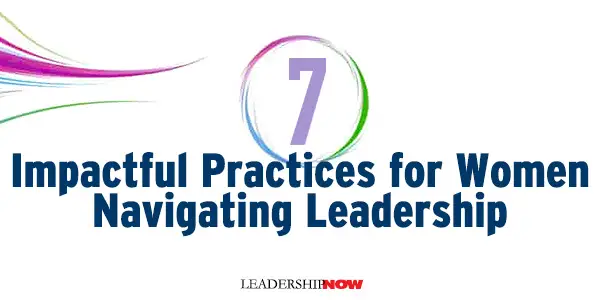
ARE you thriving as a leader? Arrive And Thrive: 7 Impactful Practices for Women Navigating Leadership is written by three successful leaders, Janet Foutty, Lynn Perry Wooten, and Susan MacKenty Brady. Together they offer seven key practices to thrive as a leader. Practice 1: Invest in Your Best Self This practice boils down to knowing yourself and is the foundational practice. When you know yourself—strengths and weaknesses—you can learn to lead from your best self. It really isn’t about loving yourself but having a grip on reality regarding your strengths and weaknesses and how they affect your leadership. Or how other people see you and where you might need to improve. Nevertheless, as the authors say, your greatest room for growth is in the areas of your greatest strengths. You want the bulk of your work to draw on your strengths, although not all of your work will. When we get kicked out of our best self (our flow) into any number of less productive places, it’s usually because something happened. This is when practice four comes into play—pausing to reflect. The reason you must practice mindfulness (noticing) and then pause as quickly as possible (other than all of the consequences for you and your relationships if you don’t) is because the best part of you just got hijacked by your own brain. These moments can turn into a lifetime of anger and fear-based psychological warfare, or these moments can turn into opportunities to practice compassion with self and others and ultimately leave you feeling at peace. War won’t get you back to your best self. Love will. You are in the driver’s seat. Practice 2: Embrace Authenticity Bring your whole self to work. “Being authentic self doesn’t mean we eschew filters and boundaries in our self-expression. It means we approach any challenge or opportunity from our best and most transparent self.” Expect that discovering and embracing your authentic self will feel beautiful and smooth only to a point—until you find yourself confronted with any number of obstacles that may result in: Practice 3: Cultivate Courage Commit to action. The practice of courage will enable you to overcome setbacks and lead more powerfully. Cultivating personal courage requires you to acknowledge what you don’t know, ask for help, and act despite risk of failure. All three actions are likely to invite feelings of discomfort and vulnerability. Practice 4: Foster Resilience “Resilience is doing well when you shouldn’t be doing well,” says the executive director of the Global Center for Resiliency, Amit Sood. It requires adaptability. The authors suggest becoming a positive deviant—that person who can find a better and more successful solution to the problem even though they have the same resources as the rest of the group. Fostering resilience means proactively preparing for the often unexpected twists and turns that life brings, and rising up through challenges stronger and wiser. Resilience is the ability to bounce back and adapt. With every bounce back, you become a better version of yourself. Practice 5: Inspire a Bold Vision Inspiring a bold vision begins by noticing. Discovering what needs to change and then taking steps to make it happen. A network for building a vision is not incidental. The offering of this practice builds down to believing in yourself and trusting your judgment as you enroll others, organize a path that will reach the desired destination, and be the one who harnesses the energy of others to achieve it. Practice 6: Create a Healthy Team Environment This practice is about personifying your organization’s values while creating a supportive, collaborative, and healthy environment. Leading from your best self, this practice is about getting others to lead from their best selves. Every individual brings something unique and powerful to the team, and conversely, every induvial retains areas where they are just not strong. Further, it is up to you (the leader) to work with the individual to help them know how they naturally excel, where they need help from teammates, and what shared goals or purpose they’re all using a strengths-based approach to achieve. Specifically, we suggest you use a strengths-based approach to intentionally promote effective delegation, successful partnerships, and deeper collaboration, among other outcomes. Practice 7: Lead Inclusively Being an inclusive leader means modeling it for others, knowing yourself, understanding your biases, and supporting others. As an inclusive leader, you can focus on what you do best and partner with others who are also bringing their best to the table. Together, you will discover more creative, compelling solutions, and you’ll do it from an approach that is much more sustainable. Inclusive leadership means going from the “me” to the “we” and creates a whole that is greater than the sum of its parts. All of these practices work to support each of the other ones. Although written specifically to women and for women, Arrive And Thrive offers valuable advice to anyone wishing to overcome these common obstacles and thrive in and out of the workplace. As Indra Nooyi writes in the book’s foreword, “the themes explored in this book, when viewed all together, wield immense power in helping anyone thrive in a leadership position.” 
Posted by Michael McKinney at 08:18 AM
04.14.22

Leading Thoughts for April 14, 2022
IDEAS shared have the power to expand perspectives, change thinking, and move lives. Here are two ideas for the curious mind to engage with: Creative director, designer, and agency owner Michael Janda believes every position can be electrifying: “You don’t have to be the art director, creative director, CTO, or VP of blah-de-blah agency to be a key member of a company. Any role, any position, in any organization can have a huge impact on the success of the organization. Throughout my career, I have seen junior programmers and junior designers make HUGE impacts on company success. By striving to maximize your contribution, regardless of the position you fill on the org chart, you can make an impact.” Source: Burn Your Portfolio: Stuff They Don’t Teach You In Design School But Should The twentieth president of the United States, James A. Garfield, on the sovereignty of the family: “There are several sovereignties in this country. First, the sovereignty of the American people, then the sovereignty nearest to us all—the sovereignty of the family, the absolute right of each family to control its affairs in accordance with the conscience and convictions of duty of the heads of the family. In the picture before us, that is bravely symbolized. I have no doubt the American people will always tenderly regard their household sovereignty, and however households may differ in their views and convictions, I believe that those differences will be respected. Each household, by following its own convictions, and holding itself responsible to God, will, I think, be respected by the American people.” Source: The Life and Work of James A. Garfield by John Clark Ridpath Look for these ideas every Thursday on the Leading Blog. Find more ideas on the LeadingThoughts index.
Posted by Michael McKinney at 07:24 AM
04.12.22

You Can Be Yourself Here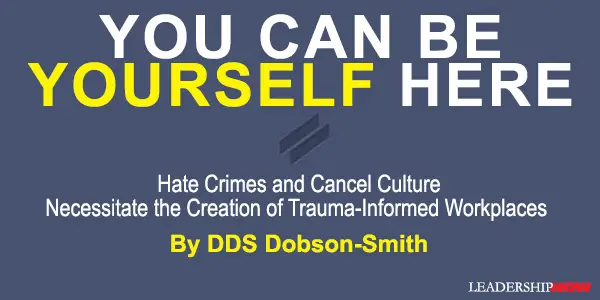
SHORTLY after the first wave of the COVID pandemic hit, I received an alarming text from a colleague of mine. It warned me of a new trend in the Bay Area called the “Slap an Asian Challenge,” in which people filmed themselves slapping Asian people and then posted it to their social channels. My husband, David, is Asian American, and my colleague was alerting us of potential danger. That same day, while they were walking to work, David was approached and harassed in broad daylight by a man wearing a mask. While not new, hate crimes (and their not-so-distant cousin, cancel culture) have been on the rise through the pandemic. Also not new and also on the rise are murders and beatings of Black, Brown, Mixed Race, and First Nations people, along with increased attacks on the queer and trans communities. The tragedies associated with the names George Floyd, Ahmaud Arbery, and Breonna Taylor placed this societal abhorrence in an appropriate spotlight. How does this violence affect the business world? Organizations now have an opportunity to be a part of the solution. They can commit to education and open dialogue to create what’s called a “trauma-informed workplace.” When implemented effectively, the result is an environment of happy, comfortable, and psychologically safe employees. If the key to any great company is its people (and it is), just imagine how beneficial this can be. Sadly, hate crime is an ugliness that we must deal with. Another ugliness, however, is cancel culture, which is a term that’s come to light in recent years. Cancel culture is engaging in mass canceling as a way of expressing disapproval and exerting social pressure. It tends to happen most when someone from the dominant social group (i.e., male, straight, white, cisgender, middle-aged, or non-disabled) is ostracized for saying or doing something hurtful to a member of a community that’s historically excluded (i.e., female, Black, Brown, Mixed race, First Nations, queer, transgender, elderly, or disabled). If we want to level-up human consciousness and create a more equitable, inclusive world (which I, of course, think we do), then we have to let people feel safe in making mistakes and saying the wrong thing — without the threat of becoming canceled. Only under these conditions can learning and open dialogue about privilege and difference take place. If we don’t allow people with identity-privilege to feel safe enough to muck things up and get things wrong, they won’t be willing to learn about diversity, inclusion or equity and we’ll have no hope of creating a deeper sense of belonging in the workplace. With the threat imposed by cancel culture, why would they? They feel safer staying away from those discussions because when they get involved, they risk exposure and, ultimately, getting voted off the island. People need to feel a psychological safety net when taking part in the discussions of a trauma-informed workplace. They need to act with intentional bravery to step into that space. Then, it’s up to organizational leadership to make sure they’re not canceled for saying or doing something unacceptable. We don’t need to just cancel hate crimes. We also need to cancel cancel culture. Leaders of organizations must create trauma-informed workplaces to help those who have suffered a hate crime, been subject to cancel culture, or who have dealt with the challenge of being excluded in some way. Concepts like employee resource groups and safe rooms have recently been proven effective to help people process tragic events. Companies that create “safe rooms” and “intentionally brave spaces” where the delicate (and oftentimes messy) conversations can take place give their staff the psychological safety net necessary for processing complex trauma and the harm inflicted by systemic oppression and day-to-day microaggressions. But simply declaring a space as “intentionally brave” and explaining to folks in the room a requirement for them to consciously, willfully, and intentionally bring courage, vulnerability, patience, and empathy isn’t enough. An additional step of co-creating rules for the room can encourage commitment. Here is a simple method for setting the stage to process trauma and oppression at your workplace:
I’ve seen safe rooms and intentionally brave spaces effectively emerge in response to the murders of George Floyd, Breonna Taylor, and Ahmaud Arbery as a way for Black employees to process and share their thoughts and fears. Similarly, they provided space to process the 2016 massacre at Pulse Nightclub, a gay nightclub in Orlando, Florida. Safe rooms allowed folks to share their sorrows and anxieties, to be seen and heard, and to be held in their grief. While some leaders may think of safe rooms and intentionally brave workspaces as a distraction from work, I see it as a necessary component for processing these tragedies in the workplace that actually leads to employees being more available for their job, not less. It gives staff a sense that their organization supports them, nurtures them, and provides them with the kinds of opportunities that they need and want. What’s more, this step can go a long way in helping all of us to understand each other better and create not just a better place to go to work but a better world in which to live.  
Posted by Michael McKinney at 05:26 PM
04.08.22

Pitch Like Hollywood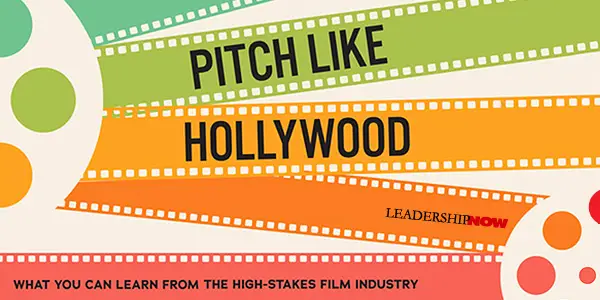
HOLLYWOOD is a tough place to pitch. In Pitch Like Hollywood, clinical psychologist Peter Desberg and writer/producer Jeff Davis take us inside to understand the process. “Hollywood has its own form of pitching,” they write. “It employs the traditional elements of pitching used in business but adds other elements to make it more persuasive and emotionally engaging.” Hollywood pitches use characters and conflicts to tell stories that leave audiences needing to know more, Hollywood artists have been pitching the same product for over a hundred years. Give creatine people a quick hundred years, and it’s not surprising that they develop a unique type of pitch. And we can learn from that and incorporate it into what we do every day to influence others for better outcomes. In a world where not-so-good ideas are being listened to way too much, we need a better way to get our ideas heard (provided they are good ones!). A pitch is when you are trying to promote an idea, a business project, or a script. It is the essence of influence. The pitch is a solution to a problem. If you don’t have a problem to solve, there’s no need to pitch. But you are not trying to sell. You are trying to start a conversation. The best pitches use a three-act structure. The pitch should have a hook and a logline. A hook is designed to grab your attention. They are short, engaging, memorable, and unusual. The logline is a short description of the idea you’re presenting. It introduces the protagonist and the antagonist, introduces the main conflict, and gives a hint of the arc. At first blush, it may seem like pitching a story is very different than pitching a business idea. A Hollywood pitch begins by presenting the world as it is: “What products in your field already exist? What service do they perform well? What don’t they do? What are they missing? With this last question, you are laying out your idea in context with the accompanying challenges and problems involved in implementing it.” In Act I, present the “setting for the problem or situation that your idea will solve by providing two key pieces of information. First, you want to orient your audience by laying out the problem area your project will resolve. Second, you introduce the source of conflict. This lets your audience know what problems must be overcome and stimulates their curiosity making them want to hear more.” Act II “deals with previous attempts to resolve the conflict, laying out the problems that were encountered. The emphasis is on problems rather than solutions, making it appear that it’ll be difficult to work things out. The goal is to maximize the audience’s curiosity and add a bit of surprise. Act III “ties everything together. You demonstrate how the conflict is resolved, and your audience hears your data in context as the solution to the problem you introduced at the beginning. If you’ve done your job well and told a great story, your audience will want to see your business plan.” The goal of pitching is collaboration. If you give too little or too much detail, you don’t allow others to get in on it. “When you’re pitching an idea, try to draw people into it. Encourage them to contribute their ideas and show enthusiasm for those ideas. It’s a sign that they’re stimulated by your ideas and want to get involved.” The former president of Hughes Entertainment explains how to avoid excessive detail this way. Imagine you’re at the coffee machine talking to your coworkers on Monday morning telling them about this great movie you saw over the weekend: You’re sharing the cool things about the movie you saw. The things that caught your imagination; the things you remember. You’re sharing the excitement. For me, that’s the key to pitching. If you start throwing in too many details your coworkers will duck for cover on Monday mornings when they see you walking down the hall. When you are called in to give your pitch, and they begin with, “Tell me a little bit a bit yourself,” you don’t want to start reeling off facts about your life. “It shows a considerable poverty of imagination.” Instead, you want to start a conversation, not rehash your credits. In creating your elevator story, it is important too, to know what to leave in and what to leave out of your pitch. A man and a woman are chatting at a cocktail party. The man asks, “What do you do?” To get into the minds of your listeners, when presenting something—especially something new—you need to connect it with something they already know. “The more original your idea is, the tougher it may be to sell, because there isn’t a precedent to show it can work. Improve your pitch by using a similar context and examples of successful precedents, but also by showing the point of departure.” The authors cover the psychology and art of persuasion and the panic that can set in before the presentation, the stage fright you feel when presenting, with informative expert examples and exercises to help you work through the issues. 
Posted by Michael McKinney at 10:10 AM
04.07.22

Leading Thoughts for April 7, 2022
IDEAS shared have the power to expand perspectives, change thinking, and move lives. Here are two ideas for the curious mind to engage with: Wayde Goodall on why people fall: “There are reasons people make bad choices, and it doesn’t happen overnight. There is an evolution—one thought, decision, or move at a time. They decided to go to the wrong place, ask the wrong question, look at illegal or immoral materials, or have a conversation with someone they knew was compromising. The behavior began somewhere. Source: Why Great Men Fall Ringo Starr on Paul McCartney’s work ethic: “The other side of that is—I was telling someone the other day—if Paul hadn’t been in the band, we’d probably have made two albums because we were lazy buggers. Source: BBC Interview: Ringo Starr - Talks about Change The World EP, Beatles, Joe Walsh & more Look for these ideas every Thursday on the Leading Blog. Find more ideas on the LeadingThoughts index.
Posted by Michael McKinney at 07:15 AM
04.04.22

Leadership Agility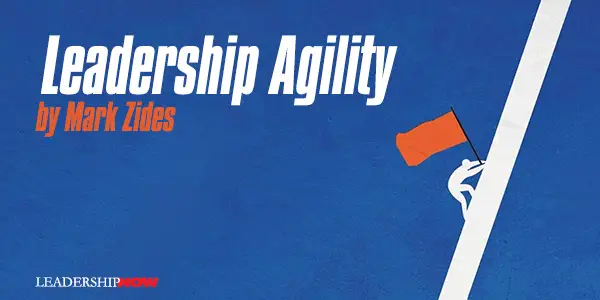
WHY do you think agility is a term used when talking about successful leadership? Is it because you will need to make decisions and act quickly as a leader? Is it to keep up with the ever-changing work environment we see these days? Is it because you need to be able to understand all sides fast and decide with only what you have? The reality is the answer is all of the above. Leadership agility is your ability to move, think, understand, act, and decide fast as a leader. You have to know your workspace, identify motivations and values that drive not only you and the organization, but your team, maximize creativity, and transition your leadership style and team to a self-organized system. Assess Your Workspace As leaders and managers, we need leadership agility to help us understand the needs of the organization and the needs of all our employees. In order to do so, you have to know the ins and outs of your workspace. Who is the go-to employee people rely on for information? Who acts fast and has a “let’s get it done now” attitude? Who steps back and asks all the right questions? Who can you count on for a creative touch? Getting to know your workspace is more than knowing the layout of your office and the chain of command to the top – it’s also about identifying talent and using individual skills to yield best results. If you need a catchy flyer created, and an employee in Education Services happens to be great a photoshop and creating copy, you may want to ask that person to help, even if it’s not part of their job description. You have a prospect who wants a deep dive of your sales pitch and the products and services you sell, and the Business Analyst on the product development team can explain the intricacies of the product without being too technical, ask that person to present to the potential client. You may have people who do not want to work outside of their job description, and that’s part of getting to know your workspace. People often can give you more than what they signed up. Identify the Motivations and Values While assessing your workspace, it is important to figure out what motivates your team. Is your team motivated by their commission checks? Are your employees motivated by collaboration with other departments? Is your team motivated by paid time off / vacation days? Whatever it is, figure it out and use it to get everyone’s blood flowing. If you are able to offer additional vacation days to the person that presents the best outcomes for a project, do it. If you can do quarterly commission check additions that help your sales team compete for the highest revenue for the quarter, do it. If you can get other departments to work together to increase the productivity and attention given to a project, do it. When your employees see that you are trying to help them grow and push them to be better versions of themselves, you will see results. Maximize Creativity Leaders tend to have creative minds, and creativity is not a one-size-fits-all term. Some people are artistically creative, some are organizationally creative, and some are creative with their problem-solving. Maximize yours. Put your creativity on display. Lead by example. If your employees see you using your creativity, showing that “no question is a stupid question” and that you’re thinking outside the box, they will more than likely be less afraid to put their ideas idea out there. It’s all about leading by example. Transition to a Self-Organized System A strong, agile leader is organized. That leader will then share their organizational knowledge with others to create a system. A self-organized system is one that does not depend on or wait for a manager to assign work or give instruction. This is something extremely important because it enables the team to find their own work and manage their timelines and responsibilities with minimal handholding. Transition your leadership style and team to a self-organizing system will streamline processes, let people know who and where to go with they need something, and will inspire creative and collaborative solutions – no matter what type of job you have. As a leader, you want to remove roadblocks. You want your employees to succeed, to be more productive and effective in their roles. It relies on trust, transparency, and a team that is open to constructive criticism. An agile leader shares his vision with his team, and they execute on all levels together.  
Posted by Michael McKinney at 09:01 PM
04.01.22

First Look: Leadership Books for April 2022Here's a look at some of the best leadership books to be released in April 2022. Be sure to check out the other great titles being offered this month.
You've long been told to "Do what you love." Sounds simple, but the real challenge is how to do this in a world not set up to help you. Most of us actually don't know the real truth of what we love—what engages us and makes us thrive—and our workplaces, jobs, schools, even our parents, are focused instead on making us conform. Sadly, no person or system is dedicated to discovering the crucial intersection between what you love to do and how you contribute it to others. In this eye-opening, uplifting book, Buckingham shows you how to break free from this conformity—how to decode your own loves, turn them into their most powerful expression, and do the same for those you lead and those you love.
Over a stellar career, Roger Martin has advised the CEOs of some of the world's most successful companies. From the beginning, he noted that almost every executive he talked to had a "model"—a framework or way of thinking that guided their strategy and activities. But these models tended to become automatic, so much so that when one didn't work, the typical response was just to apply it again—with greater enthusiasm. Martin took a fresh, critical approach to helping. When company leaders came to him with fundamental questions—How do you decide where to play and how to win? What is the key to shaping and changing corporate culture? How can you design a successful, sustainable innovation process?—his first response was to break the spell of the current model with a memo articulating a new way to think about the problem at hand and a more powerful and effective way to successfully overcome it.
Why is leading innovation in today’s dynamic business environment so distressingly hit-or-miss? More than 90 percent of high-potential ventures don’t reach their projected targets. Surveys show that 80 percent of executives consider innovation crucial to their growth strategy, but only 6 percent are satisfied with their innovation performance. Should leaders aim for Steve Jobs-level genius, shower their projects with resources, or lean in to luck and embrace uncertainty? None of the above, say Christopher Bingham and Rory McDonald. Drawing on cutting-edge research and probing interviews with hundreds of leaders across three continents, in Productive Tensions Bingham and McDonald find that the most effective leaders and successful innovators embrace the tensions that arise from competing aims: efficiency or flexibility? consistency or change? product or purpose? Bingham and McDonald spotlight eight critical tensions that every innovator must master, and they spell out, with dozens of detailed examples of both success and failure, how to navigate them.
Cut through the noise and create the biggest possible audience for your work. This book offers a proven method for expanding your reach online so you can make a meaningful difference for others. Anyone who makes the bold decision to put their ideas out into the world wants to reach as many people as possible. Unfortunately, too many think it’s a question of numbers—the more people you can get in front of, the better. But true reach is about expanding your audience while making a meaningful and enduring difference that has a lasting impact. Reach provides a clear and structured approach to creating a successful online presence that will create the biggest possible impact for any message. Becky Robinson shares a framework to cultivate followers that requires four commitments: value, consistency, endurance, and generosity. When you make these four commitments, you’ll deliver memorable content on a regular basis while keeping the long-term view in mind and being committed to helping and sharing with others.
In 2008, with no event production experience and two college degrees between the four of them, Elliott Bisnow, Brett Leve, Jeff Rosenthal, and Jeremy Schwartz became business partners and set out to build a global events company. With passion and tenacity, they began cold calling as many inspiring company founders as they could and tried to convince them to attend their first event. In the beginning, only nineteen people said yes. Since then, they have grown Summit into a global community with events all over the world, hosting luminaries including Jeff Bezos, Richard Branson, Shonda Rhimes, Brené Brown, Kendrick Lamar, and Al Gore. In 2013, the Summit founders acquired Powder Mountain, the largest ski resort in the United States, with a dream of building a mountaintop town of the future. In Make No Small Plans, they reveal the triumphs, mistakes, and cornerstone lessons from their journey, which began during the Great Recession and continues today.
In their groundbreaking book, Human + Machine, Accenture technology leaders Paul R. Daugherty and H. James Wilson showed how leading organizations use the power of human-machine collaboration to transform their processes and their bottom lines. Now, as AI continues to rapidly impact both life and work, those companies and other pioneers across industries are tipping the balance even more strikingly toward the human side with technology-led strategy that is reshaping the very nature of innovation. In Radically Human, Daugherty and Wilson show this profound shift, fast-forwarded by the pandemic, toward more human—and more humane—technology. Artificial intelligence is becoming less artificial and more intelligent. Instead of data-hungry approaches to AI, innovators are pursuing data-efficient approaches that enable machines to learn as humans do. Instead of replacing workers with machines, they're unleashing human expertise to create human-centered AI. In place of lumbering legacy IT systems, they're building cloud-first IT architectures able to continuously adapt to a world of billions of connected devices. And they're pursuing strategies that will take their place alongside classic, winning business formulas like disruptive innovation.
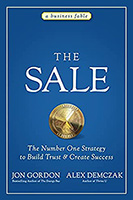 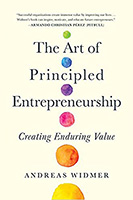 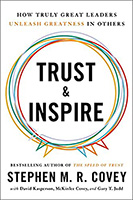
 Build your leadership library with these specials on over 28 titles. All titles are at least 40% off the list price and are available only in limited quantities. “He that loves a book will never want a faithful friend, a wholesome counselor, a cheerful companion, an effectual comforter. By study, by reading, by thinking, one may innocently divert and pleasantly entertain himself, as in all weathers, as in all fortunes.” — Isaac Barrow
Posted by Michael McKinney at 05:13 AM
|
BUILD YOUR KNOWLEDGE


How to Do Your Start-Up Right STRAIGHT TALK FOR START-UPS 
Grow Your Leadership Skills NEW AND UPCOMING LEADERSHIP BOOKS 
Leadership Minute BITE-SIZE CONCEPTS YOU CAN CHEW ON 
Classic Leadership Books BOOKS TO READ BEFORE YOU LEAD |
|